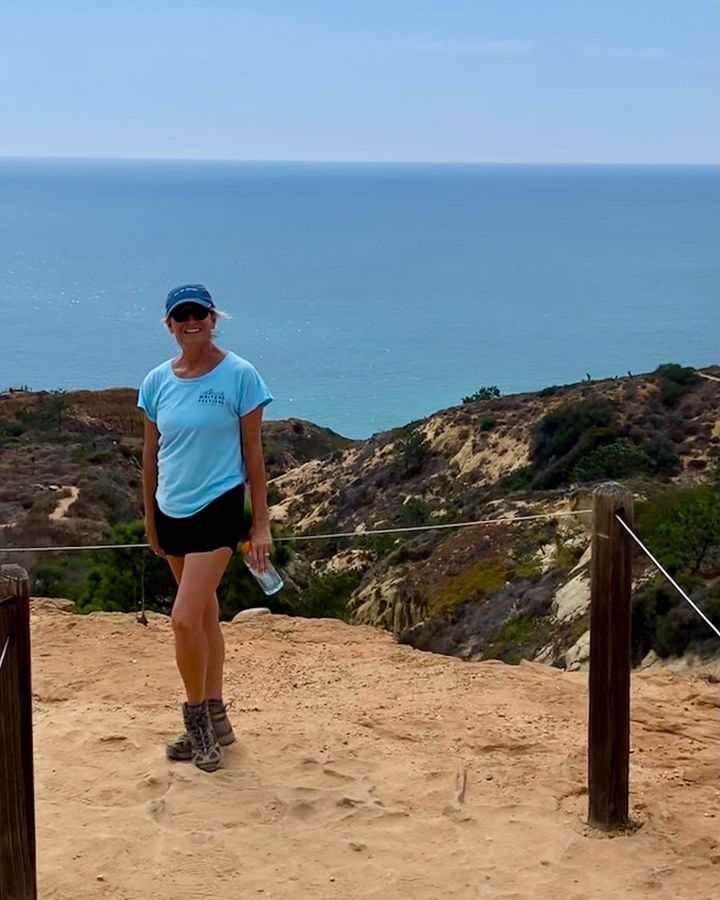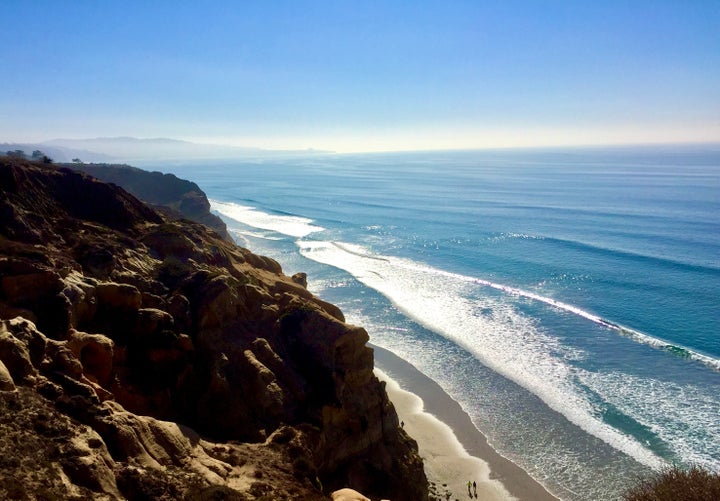
On a beautiful sunny morning in February 2021, I left my house with the intention of hiking to my favorite spot along an oceanfront trail — and jumping to my death.
Or diving.
I hadn’t decided.
I remember wondering, how long will it take to hit the ground? Three seconds? Four? Beyond that, I hadn’t given a great deal of thought to the logistics. All I knew was that I wanted the pain of my existence to end. I wanted to spare my family from having to deal with me any longer. I wanted to stop it all. To feel nothing. To be nothing.
“Did you have a plan?” a triage nurse would ask me later that day. “Yes,” I would respond, though by then, my thinking had cleared enough to recognize that it hadn’t been a well-thought-out one. I did not mention this to the nurse, nor did I mention the other plans I’d considered — driving into a cement pylon along the highway or waiting until night fell to take an overdose of sleeping pills with a glass of gin.
Of course, in retrospect, I realize my thinking was illogical that day: There was no guarantee that I’d die hitting the pylon, surviving a car accident would likely lead me to be a greater burden to my family, and when you are trying to die, you don’t need to wait until nighttime to take sleeping pills.
As I arrived at the location I’d chosen for the jump, my illogical thinking was interrupted by a flash of clarity. My children and I often hiked together to this spot — a sandy patch atop a sandstone cliff blessed with 180-degree views of the coastline, the waves rolling to shore, the vast ocean meeting the sky at the horizon. It was where I insisted we stop for “a moment of Zen” — standing, eyes closed, for a minute, just listening before opening our eyes and reflecting on how big the ocean was, how little we were, how interconnected and beautiful and peaceful it all was.
The spot held no beauty or Zen for me that day, but I remembered that it could — and realized I would be forever ruining it for my children. Maybe not just this spot. Maybe hiking. The ocean. Maybe the concepts of peace and connection.
Standing there, shaking, it suddenly occurred to me that my death would likely be damaging in more dramatic ways. I might leave my children with emotional wounds that would never heal. This was enough to keep me from following through. Enough to keep me hugging the inside of the trail until I got past the cliffs and began to climb up.
And then, as I was about to reach the end of the trail, I saw my best friend walking toward me, arms open. What are the odds? I thought before realizing she was there for me. “Hold on,” she told me. She dialed, waited and said, “I’ve got her.”
Before long, I would learn that after I left that morning without my phone, shouting at my husband, “Maybe you’ll be lucky, maybe I’ll jump,” he had called my daughter, who called my best friend, who came to help my husband look for me. The search area was large, with a dozen trails. The only luck, I thought, had been hers, choosing the trail I had chosen.
When I mentioned this to her as we waited for my husband, she said: “That wasn’t luck. The universe wants you to be here.”
I nodded but didn’t believe her. The universe didn’t care one iota. What I said out loud was “Really, though, I’m OK.”
“No,” she said firmly but compassionately. “You’re not. You’re not OK, and that is OK.” Her voice slowed. She took my hand. “But we need to do something. We need to get help so we can get you back to OK.”
Which is how, an hour or so later, I ended up making what might have been the hardest call of my life. I sat outside in my backyard and dialed. Tempted to hang up, tempted to lie, again, and say, “Never mind, I’m OK,” I remembered my best friend’s words. My voice shook. Tears fell as I admitted that I’d wanted to die. That I’d had a plan and been ready to go through with it, but didn’t. That I was back home.
The triage nurse listened, then asked, “Are you alone?”
“No,” I said. “My husband is here.”
“Are you still having suicidal thoughts?” she asked.
“No,” I said again. “Not like this morning.”
“Not like this morning,” she said, somewhere between a statement and a question. “To be clear, do you still want to end your life?”
“No,” I said, then repeated, “no,” more firmly. “But I can’t live like this anymore. I need help.”
“OK,” she said. “Here’s what’s going to happen. You’re going to get a call in the next couple of hours from a social worker and a psychiatrist, and we’re going to help you. But, and this is important, if at any time you want to take your own life, you need to call us or call 911.” She paused, then said, “24/7, someone will be there on the other end of the phone.”

It was then that the relief came. A burden began to lift from my body — a burden I’d carried for decades. Despite having said, “I’m OK,” for longer than I could remember, I hadn’t been for a long, long time. I just hadn’t realized that I’d been carrying the burden of depression and anxiety everywhere: in my lungs, my head, my shoulders, heart, legs.
Within hours, I was presented with options, steps, and hope. Medication. Cognitive behavioral therapy (CBT). Talk therapy. Meditation. Yoga. Over the next few months, l tried them all. And slowly, fitfully, something began to change.
It was not, however, clear sailing. The first two prescribed meds didn’t work. The third, which worked incredibly well, caused an extraordinarily rare side effect that nearly took my life. This became a lesson in and of itself; when I ended up physically sicker than I’d ever been, I realized I no longer wanted to die.
I wanted to live.
Eventually, my doctors and I found the right combination of medications. I used CBT techniques to reframe my thoughts. I stopped waking every night at 2 a.m. to chronicle my mistakes and plunge deep into self-loathing. I wrote about the journey, and I began to talk about it privately and publicly. On social media. In articles. On podcasts.
“What would have helped you on that sunny day back in 2021?” a podcast host recently asked me. I thought about this. I said, “That’s a good question,” to give myself time to think — and because it was a good question.
What would have helped? I asked myself, and the answer came to me. To be sure, I’d lost hope when I’d left the house that morning, but mostly, I’d felt alone.
“If my husband had said that morning, ‘Here’s what we’re going to do,’” I began. “We’re going to call the emergency line together. I will be here by your side. You are not alone.” I paused, then clarified: “I’m not blaming him. I know he wanted to help me. I also know he didn’t know what to say — or what to do.”
I understood this; I had been in his position. Many times. In 2002, when I found out that a dear friend was buying new underwear for her children every week because she was too depressed to do laundry, I was bewildered and scared to visit her because I didn’t know what to say. When my 18-year-old daughter told me in 2010 that she’d been depressed for at least two years, I was shocked and didn’t know what to say. In 2012, when my nephew tried to end his own life, I was worried that I’d say the wrong thing, so I didn’t say anything at all. This is common when it comes to talking about mental health and suicide.
People care, deeply. They just don’t know how to help. But as with so many things in life, we can learn, particularly if we seek it out and are pointed in the right direction.
Along these lines, I recently learned that the 988 hotline provides support not only to those struggling with mental illness but also to their families, friends, colleagues and communities. This is true for a host of organizations, like the National Alliance on Mental Illness, the National Institute of Mental Health and the American Foundation for Suicide Prevention, among others. They recognize the need to educate people about the signs of mental illness and suicide, so they know what to look for.
The real luck on that sunny day in 2021 was that my best friend was there to say exactly what I needed to hear: “We need to get you help.”
The gift of that day was learning that in the worst of moments — when we want to end it all — one person being there can make all the difference. One person listening and knowing what to say can help us find our way to the other side of nothing — to something. To hope, meaning, love, belonging, gratitude. To all of it. To life. To everything.
With knowledge, compassion and empathy, I can be that person for someone. So can you.
Anastasia Zadeik is the author of two books:“Blurred Fates,” which won both the 2023 Sarton Award and the 2023 National Indie Excellence Award in Contemporary Fiction; and “The Other Side of Nothing,” which Kirkus called “a stunning story about mental illness and its challenges.” Anastasia serves as Director of Communications for the San Diego Writers Festival and as a mentor and performer for the literary nonprofit So Say We All.
If you or someone you know needs help, call or text 988 or chat 988lifeline.org for mental health support. Additionally, you can find local mental health and crisis resources at dontcallthepolice.com. Outside of the U.S., please visit the International Association for Suicide Prevention.
Do you have a compelling personal story you’d like to see published on HuffPost? Find out what we’re looking for here and send us a pitch at [email protected].